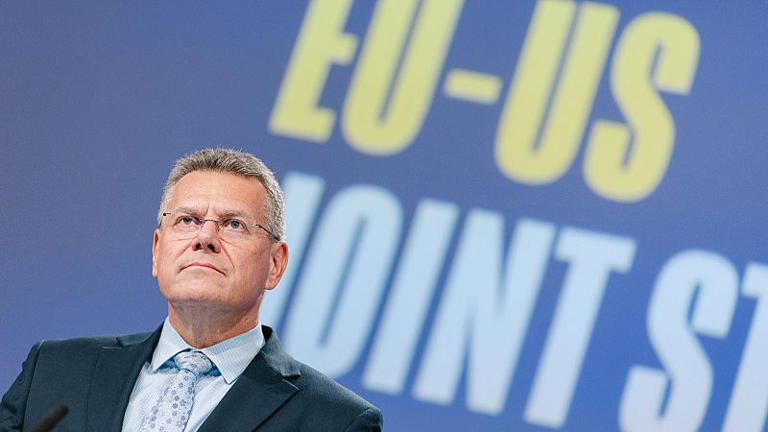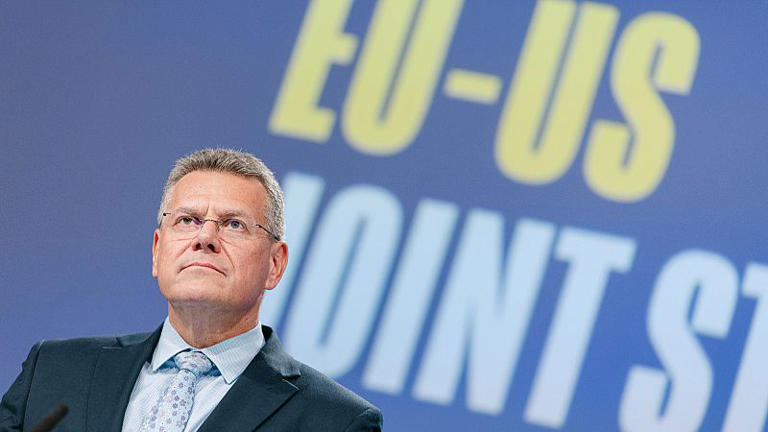
Table of Contents
- Introduction: Why the EU US Trade Deal Matters
- Key Highlights of the Trade Statement
- 15% All-Inclusive Tariff Cap
- Retroactive Tariff Benefits
- MFN Regime for Key Products
- Impact on European and American Industries
- Automotive Sector
- Pharmaceuticals & Semiconductors
- Natural Resources and Aviation
- What’s Missing from the EU US Trade Deal?
- Wines & Spirits
- Steel and Aluminium
- Political and Economic Reactions
- Why This Deal Strengthens Transatlantic Relations
- Future Outlook: What Comes Next?
- FAQs on the EU US Trade Deal
- Conclusion
1. Introduction: Why the EU US Trade Deal Matters

The EU US trade deal unveiled this week marks a turning point for transatlantic commerce. For decades, tariffs have been a sticking point in negotiations between Brussels and Washington. Now, with the announcement of a 15% all-inclusive tariff ceiling, both sides are signaling their commitment to stability, predictability, and stronger economic cooperation.
2. Key Highlights of the Trade Statement
15% All-Inclusive Tariff Cap
The most striking element of the EU US trade deal is the introduction of a maximum 15% tariff on cars, pharmaceuticals, and semiconductors entering the United States. This is a substantial reduction from the current 27.5% customs duty applied to European cars and car parts.
Retroactive Tariff Benefits
According to EU Trade Commissioner Maroš Šefčovič, if the legislative process begins before the end of the month, the reduced tariff rates will be applied retroactively as of August 1st, 2025. This is expected to bring immediate relief to exporters.
MFN Regime for Key Products
Starting September 1st, products like cork, aircraft, aircraft parts, generic pharmaceuticals, and chemical precursors will enjoy Most-Favored-Nation (MFN) status. This ensures equal treatment in line with global trade rules.
3. Impact on European and American Industries
Automotive Sector
The automotive industry stands to benefit the most from the EU US trade deal. Lower tariffs will not only reduce costs for European carmakers but also make EU vehicles more competitive in the US market. American consumers could see lower prices and more choices.
Pharmaceuticals & Semiconductors
While pharmaceuticals and semiconductors already benefit from MFN tariffs, the new agreement ensures protection against potential tariff hikes. This is especially crucial in the wake of supply chain disruptions during recent global crises.
Natural Resources and Aviation
For industries relying on natural resources like cork and aviation components, the continuation of MFN tariffs secures stable pricing and reduces uncertainty for manufacturers on both sides of the Atlantic.
4. What’s Missing from the EU US Trade Deal?
Wines & Spirits
European wine producers, particularly in France, expressed disappointment as wines and spirits were excluded from the tariff reductions. These remain subject to existing duties.
Steel and Aluminium
No breakthrough has been reached on steel and aluminium, where tariffs remain at a steep 50%. Both sides agreed only to “work together” toward a tariff quota solution, but no timeline has been set.
5. Political and Economic Reactions
Leaders like Ursula von der Leyen and Antonio Costa hailed the deal as a victory for stability. EU ambassadors responded positively, noting that this is one of the most favorable trade arrangements the US has ever extended to a partner.
Šefčovič, who spent over 100 hours negotiating, called it a “first step” toward strengthening economic ties, while also stressing its role in the broader geopolitical landscape.
6. Why This Deal Strengthens Transatlantic Relations
The EU US trade deal is more than just tariffs—it’s a signal of renewed partnership. In an era of global uncertainty, closer trade relations between the EU and the US help ensure supply chain security, market stability, and economic resilience.
7. Future Outlook: What Comes Next?
While the deal is a strong foundation, several unresolved issues remain—especially in steel, aluminium, and agricultural products. Negotiations will likely continue throughout 2025, with the potential for broader agreements in energy, digital trade, and green technologies.
8. FAQs on the EU US Trade Deal
Q1: What is the main achievement of the EU US trade deal?
A: The cap of 15% on cars, semiconductors, and pharmaceuticals is the deal’s biggest win.
Q2: When will the new tariff reductions apply?
A: If passed, they will apply retroactively from August 1, 2025.
Q3: Are wines and spirits included in the deal?
A: No, they are currently excluded, though talks may expand later.
Q4: What happens to steel and aluminium tariffs?
A: They remain at 50%, with discussions ongoing.
Q5: How does the deal affect American consumers?
A: Lower tariffs mean cheaper cars and pharmaceuticals from Europe, with better product variety.
Q6: Is the deal legally binding?
A: Not yet—it is a joint statement outlining intentions, with legislative steps still required.
9. Conclusion
The EU US trade deal is a historic breakthrough, offering businesses on both sides of the Atlantic reduced tariffs, greater market stability, and improved supply chain predictability. While some sectors remain unresolved, this agreement represents a positive step toward deeper transatlantic cooperation.
For policymakers, businesses, and consumers alike, this deal isn’t just about trade—it’s about building a stronger economic future. Read More Tech News


